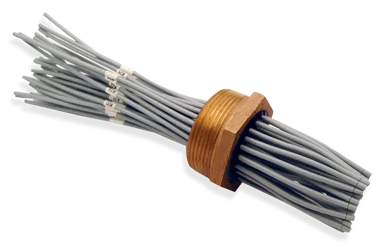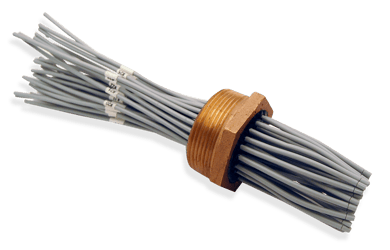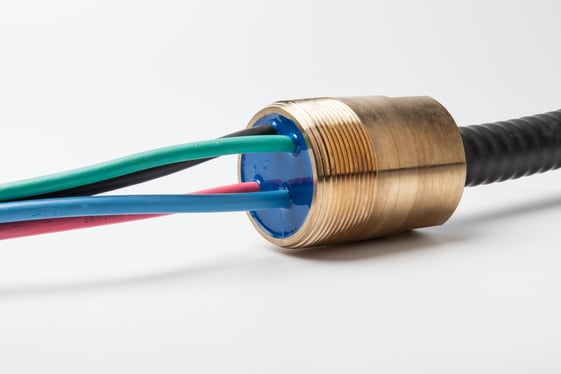Douglas Electrical Components wire feedthroughs and line bushings are often compared to wire feedthroughs that are hermetically sealed using conduit cement within a metal housing. Conduit cement is a traditional bonding substance for sealing electrical systems and conduits whereas epoxy in wire feedthroughs and line bushings can be more suitable for preventing the entry of moisture, containments, and hazardous atmospheres. Both sealing technologies are designed for explosive atmospheres with third-party certification standards domestically and internationally.
For union fittings with a cement seal, a technician in assembly or engineering will run wire or cable through the union fitting, clean the surface, mix and pour the cement within the feedthrough housing (usually with a third port specifically for wiring and pouring) and let the fitting cure.
Douglas Wire Bushings come pre-potted, tested, certified for hazardous locations, and ready for installation.
Depending on the application, Douglas Electrical Components can seal to the jacket of the conductor or directly to the conductor, jacket, and housing. While standard housings are available, Douglas can also customize the housing design and material to create the most efficient installation method for your system.
Comparison between Epoxy Technology and Cement-based solutions
- Brittleness – The flexibility of epoxy contributes to its ability to withstand stresses and movements without easily cracking or breaking. On the other hand, some cement-based materials are more likely to break under certain situations. Douglas’ epoxy technology is available to operate from cryogenic temperatures and pressures to 15,000 PSI.
- Chemical resistance – Epoxy is a more modern material designed to be in direct contact with various liquids and gases, many of which are corrosive in nature. Epoxy stands out for its excellent resistance to chemicals, ensuring durability in hermetic sealing applications, especially when the sealed environment may encounter corrosive or reactive elements.
- Processing time – The manufacturing process to mix, pour, and cure the cement can take time not often afforded to the manufacturing process of the equipment or assembly. This quick process contributes to increased efficiency in manufacturing processes where timely hermetic sealing is essential.
- Versatility – Epoxy is highly versatile and adaptable to different shapes and sizes, making it suitable for various hermetic sealing requirements. Cement-based solutions may have limitations in terms of flexibility and adaptability to diverse sealing scenarios.
- Temperature Stability – Epoxy technology offers high temperature stability, making it suitable for hermetic sealing in environments with fluctuating or extreme temperatures. The thermal expansion and contraction properties of epoxy contribute to a stable and lasting seal. Cement-based solutions may experience limitations in extreme temperature.
Advantages of a Douglas Wire Feedthroughs and Line Bushing
- The sealing is already done. Increase manufacturing efficiency and quality with a drop-in assembly that is sealed and ready to wire.
- Buying a pre-potted and certified solution allows our customers to focus on their core competencies. It can be cumbersome and inefficient to perform potting in-house on an irregular basis; ultimately, allow the potting experts to take these assemblies off your hands.
- Wires and cables are precut to length with the exact number of conductors required for the assembly.
- Douglas uses in-house tooling to ensure every conductor is properly sealed within the housing.
- Helium leak detection via mass spectrometer and potential pressure tests beyond 10,000 PSI are available for every wire bushing, ensuring the highest quality and safety.
- Various certifications are available including UL, CSA, ATEX, and IECEx ratings to Class I Division 1 Explosion-proof and Zone 0 standards.
- We specialize in developing wire bushings for production volume assemblies with a Design for Manufacturing (DFM) mindset. This can include customization of conductor type, materials, and value-adds that decrease your assembly time.
In summary, Douglas Hermetic Wire Feedthroughs and Line Bushings outshine Conduit Cement Compound. Offering essential insulation, protection, and organization for electrical systems, they ensure superior safety and compliance. Wire Feedthroughs and Line Bushings stand as preferred choices for their comprehensive benefits, surpassing the advantages of Conduit Cement Compound in meeting diverse project requirements.
FAQs
1. Do Wire Feedthroughs and Line Bushings require regular maintenance?
Generally, wire feedthroughs and line bushings are designed to be low-maintenance. However, periodic inspections may be recommended to ensure that the components remain intact and effective. Any signs of wear or damage should be addressed.
2. Is the sealing technology used by Douglas suitable for explosive atmospheres?
Absolutely. Douglas Wire Feedthroughs and Line Bushings are designed for explosive atmospheres and comply with third-party certification standards for both domestic and international applications.
3. Can Wire Feedthroughs and Line Bushings be customized to meet specific project requirements?
Yes, Douglas specializes in customization, offering flexibility in housing design and material to ensure the most efficient installation method for your system.







